Physical Address
304 North Cardinal St.
Dorchester Center, MA 02124
| Patient History | |
|---|---|
| Complaints |
|
| Physical Examination | |
| Range-of-Motion Measurements |
|
| Strength Assessment |
|
| Special Tests |
|
| Combinations of Findings |
|
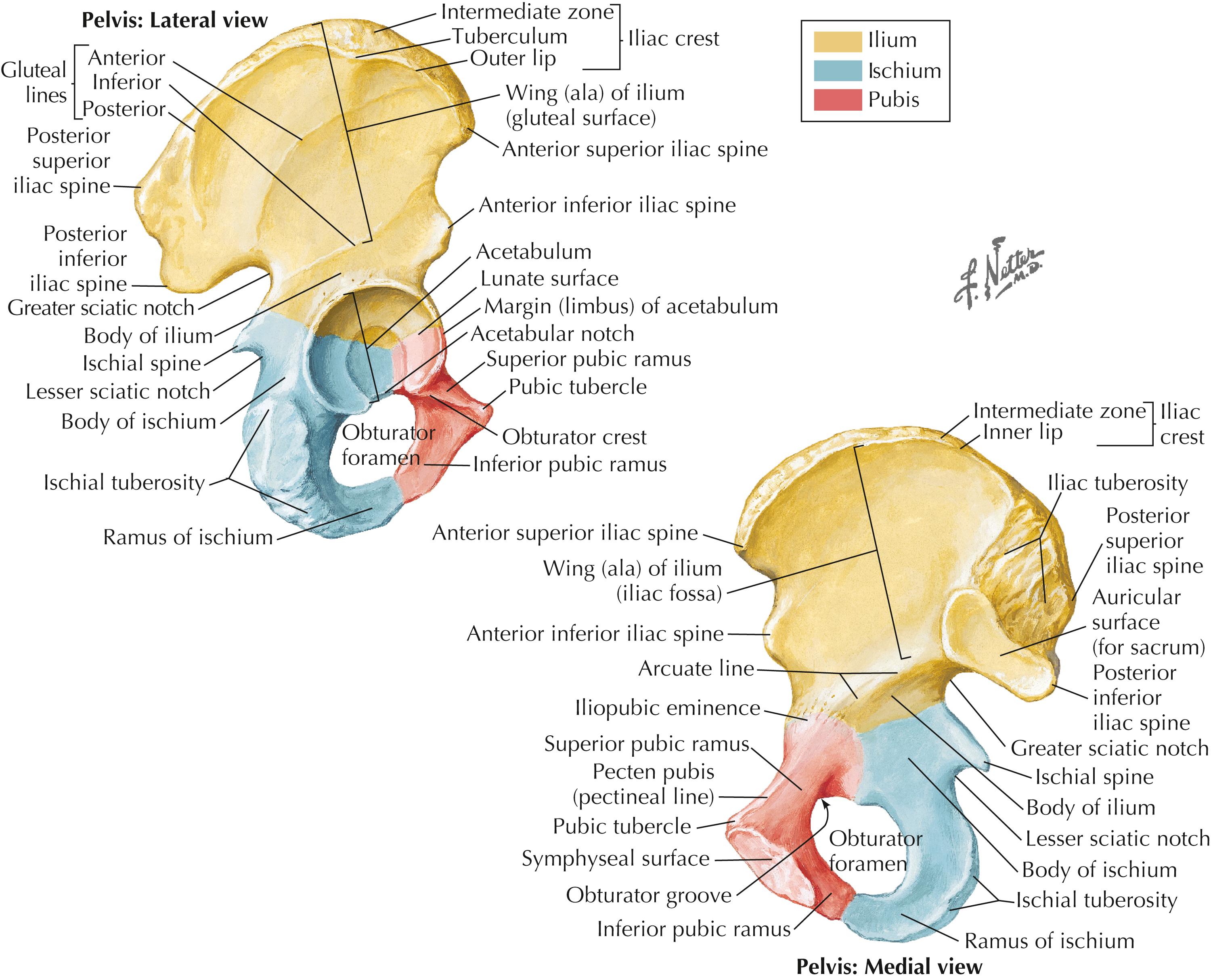
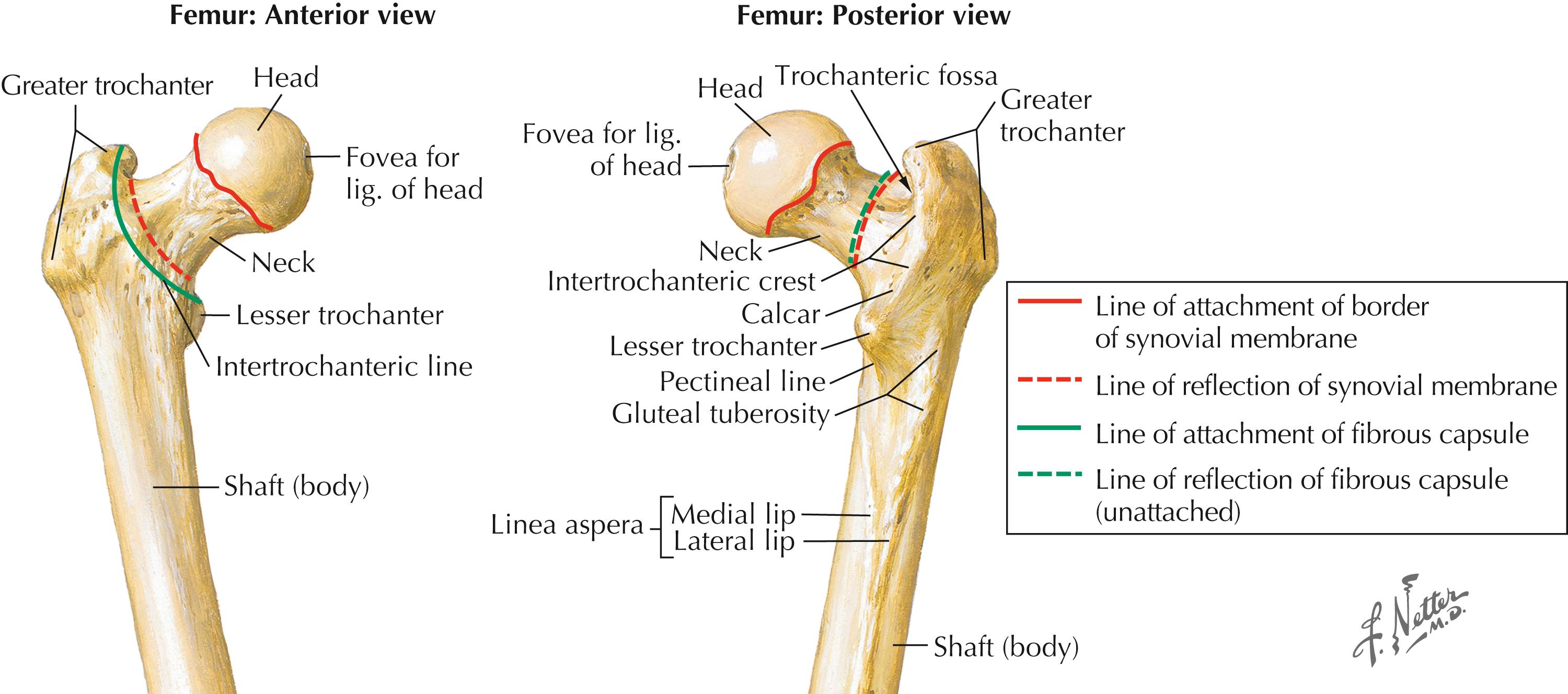
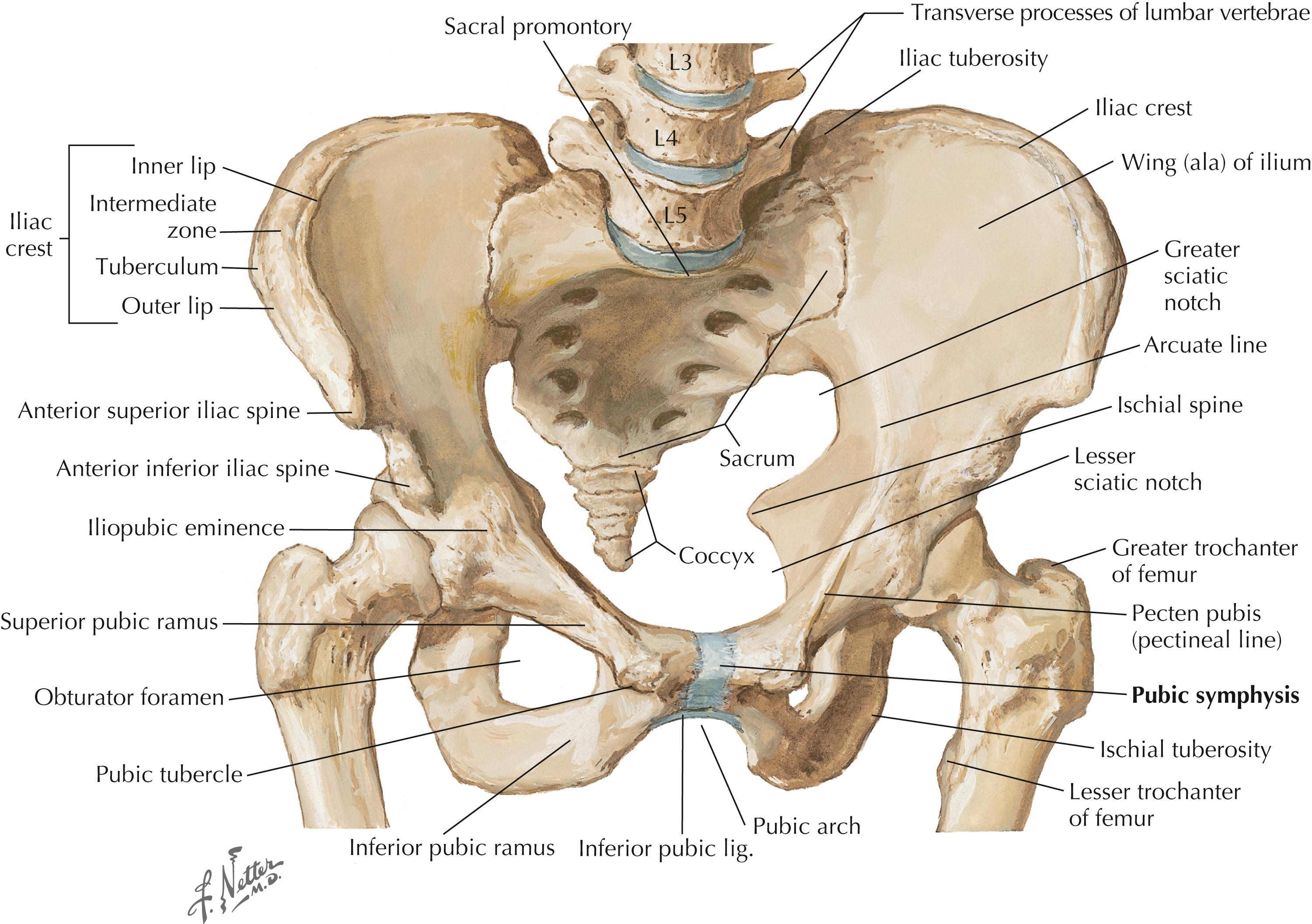
| Joint | Type and Classification | Closed Packed Position | Capsular Pattern |
|---|---|---|---|
| Femoroacetabular | Synovial: Spheroidal | Full extension, some internal rotation, and abduction | Internal rotation and abduction greater than flexion and extension |
| Pubic symphysis | Amphiarthrodial | Not applicable | Not applicable |
| Sacroiliac | Synovial: Plane | Not documented | Not documented |
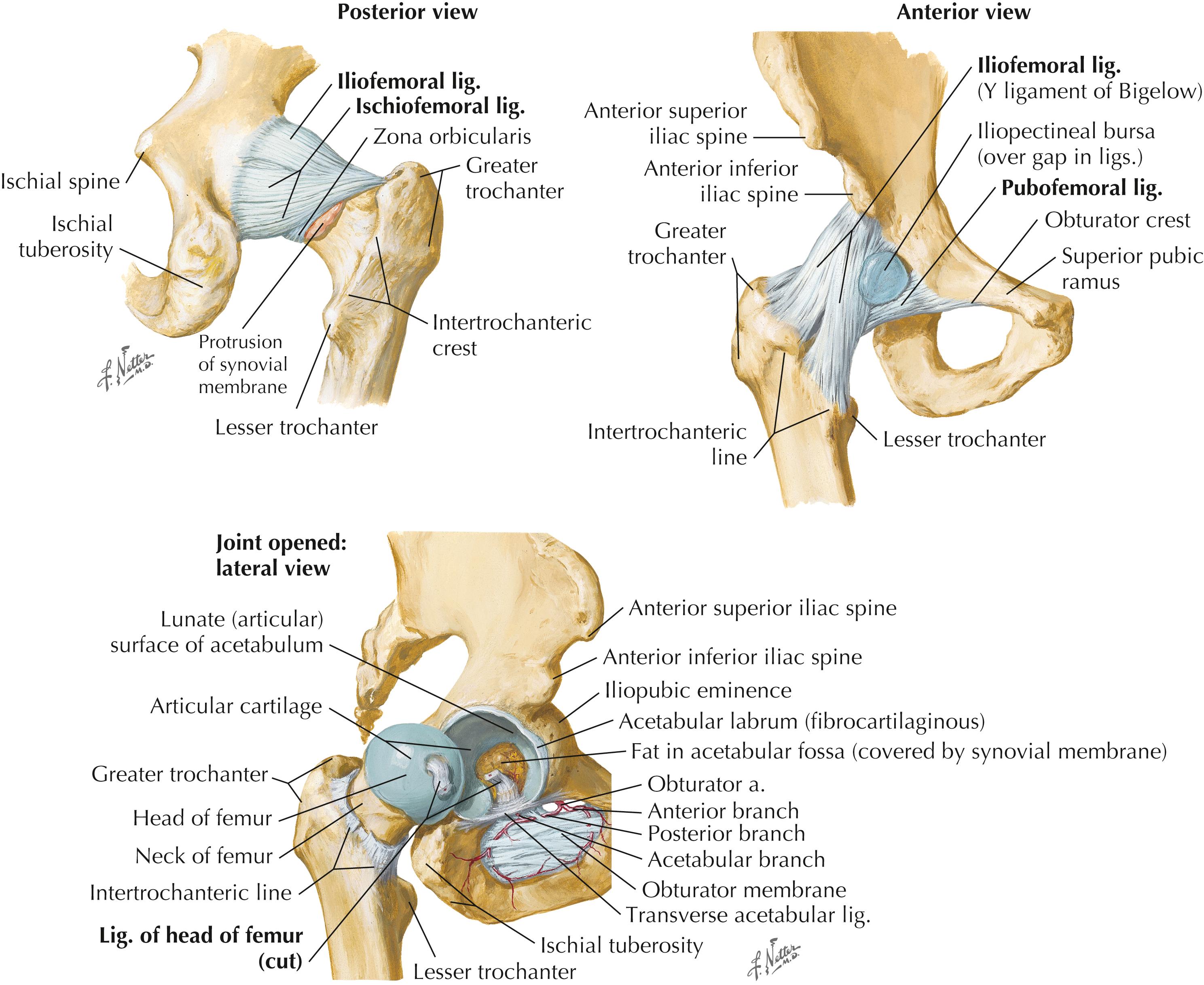
| Hip Ligaments | Attachments | Function |
|---|---|---|
| Iliofemoral | Anterior inferior iliac spine to intertrochanteric line of femur | Limits hip extension |
| Ischiofemoral | Posterior inferior acetabulum to apex of greater tubercle | Limits internal rotation, external rotation, and extension |
| Pubofemoral | Obturator crest of pubic bone to blend with capsule of hip and iliofemoral ligament | Limits hip hyperabduction |
| Ligament of head of femur | Margin of acetabular notch and transverse acetabular ligament to head of femur | Carries blood supply to head of femur |
| Pubic Symphysis Ligaments | Attachments | Function |
|---|---|---|
| Superior pubic ligament | Connects superior aspects of right and left pubic crests | Reinforces superior aspect of joint |
| Inferior pubic ligament | Connects inferior aspects of right and left pubic crests | Reinforces inferior aspect of joint |
| Posterior pubic ligament | Connects posterior aspects of right and left pubic crests | Reinforces inferior aspect of joint |
| Muscle | Proximal Attachment | Distal Attachment | Nerve and Segmental Level | Action |
|---|---|---|---|---|
| Gluteus maximus | Posterior border of ilium, dorsal aspect of sacrum and coccyx, and sacrotuberous ligament | Iliotibial tract of fascia lata and gluteal tuberosity of femur | Inferior gluteal nerve (L5, S1, S2) | Extension, external rotation, and some abduction of the hip joint |
| Gluteus medius | External superior border of ilium and gluteal aponeurosis | Lateral aspect of greater trochanter of femur | Superior gluteal nerve (L5, S1) | Hip abduction and internal rotation; maintains level pelvis in single-limb stance |
| Gluteus minimus | External surface of ilium and margin of greater sciatic notch | Anterior aspect of greater trochanter of femur | ||
| Piriformis | Anterior aspect of sacrum and sacrotuberous ligament | Superior greater trochanter of femur | Ventral rami of S1, S2 | External rotation of extended hip, abduction of flexed hip; steadies femoral head in acetabulum |
| Superior gemellus | Ischial spine | Trochanteric fossa of femur | Nerve to obturator internus (L5, S1) | |
| Inferior gemellus | Ischial tuberosity | Nerve to quadratus femoris (L5, S1) | ||
| Obturator internus | Internal surface of obturator membrane, border of obturator foramen | Nerve to obturator internus (L5, S1) | ||
| Quadratus femoris | Lateral border of ischial tuberosity | Quadrate tubercle of femur | Nerve to quadratus femoris (L5, S1) | Lateral rotation of hip; steadies femoral head in acetabulum |
| Semitendinosus (hamstring) | Ischial tuberosity | Superomedial aspect of tibia | Tibial division of sciatic nerve (L5, S1, S2) | Hip extension, knee flexion, medial rotation of knee in knee flexion |
| Semimembranosus (hamstring) | Posterior aspect of medial condyle of tibia | |||
| Biceps femoris (hamstring) | Long head: ischial tuberosity Short head: linea aspera and lateral supracondylar line of femur |
Lateral aspect of head of fibula, lateral condyle of tibia | Long head: tibial division of sciatic nerve (L5, S1, S2) Short head: common fibular division of sciatic nerve (L5, S1, S2) |
Knee flexion, hip extension, and knee external rotation when knee is flexed |
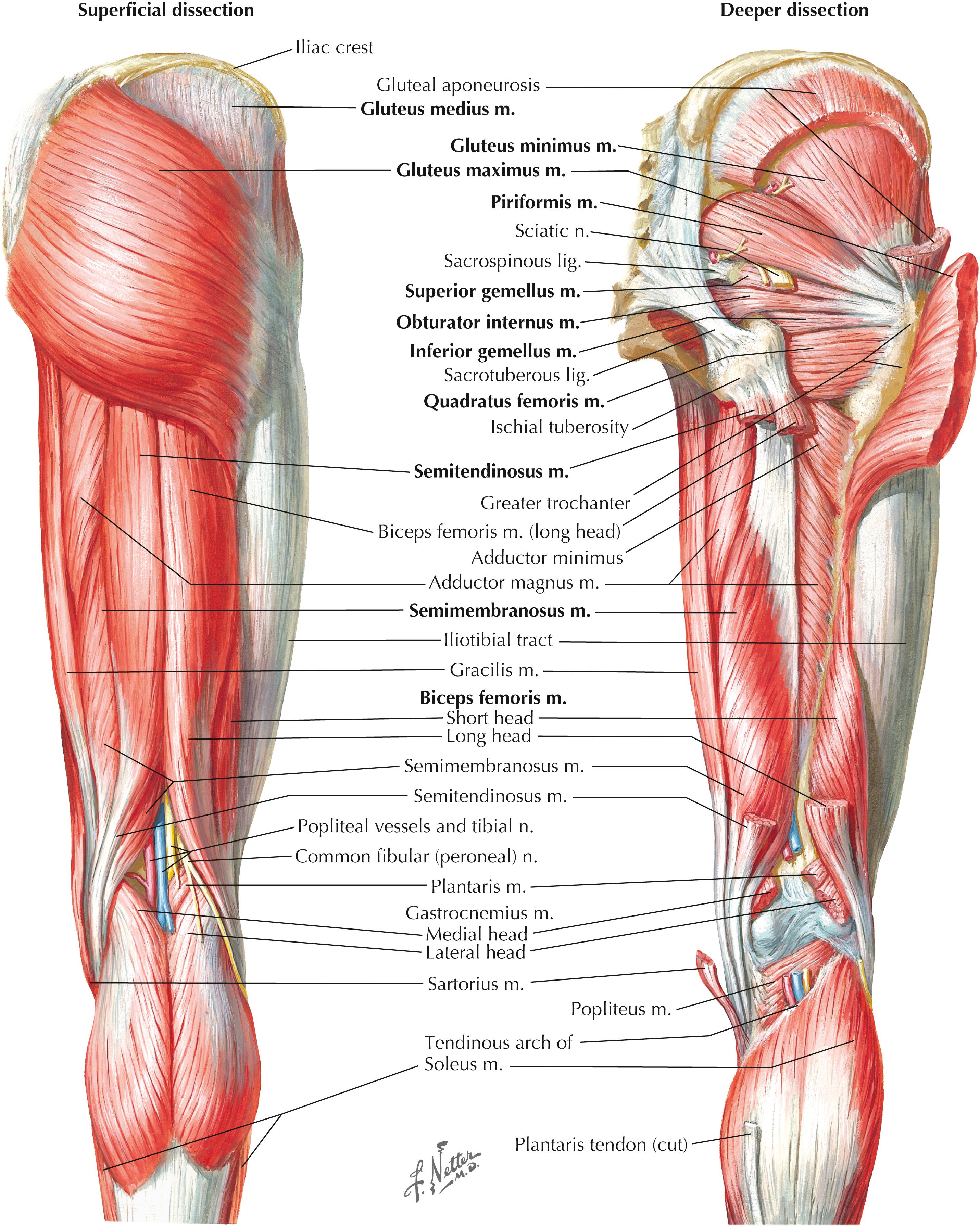
| Muscle | Proximal Attachment | Distal Attachment | Nerve and Segmental Level | Action |
|---|---|---|---|---|
| Obturator externus | Margin of obturator foramen and obturator membrane | Trochanteric fossa of femur | Obturator nerve (L3, L4) | Hip external rotation; steadies head of femur in acetabulum |
| Hip Flexors | ||||
| Psoas major | Lumbar transverse processes | Lesser trochanter of femur | L1-L4 | Flexes the hip, assists with external rotation and abduction |
| Psoas minor | Lateral bodies of T12-L1 | Iliopectineal eminence and arcuate line of ileum | L1-L2 | Flexion of pelvis on lumbar spine |
| Iliacus | Superior iliac fossa, iliac crest and ala of sacrum | Lateral tendon of psoas major and distal to lesser trochanter | Femoral nerve (L1-L4) | Flexes the hip, assists with external rotation and abduction |
| Tensor fasciae latae | Anterior superior iliac spine and anterior aspect of iliac crest | Iliotibial tract that attaches to lateral condyle of tibia | Superior gluteal nerve (L4, L5) | Hip abduction, internal rotation and flexion; aids in maintaining knee extension |
| Rectus femoris | Anterior inferior iliac spine | Base of patella and through patellar ligament to tibial tuberosity | Femoral nerve (L2, L3, L4) | Hip flexion and knee extension |
| Sartorius | Anterior superior iliac spine and notch just inferior | Superomedial aspect of tibia | Femoral nerve (L2, L3) | Flexes, abducts, and externally rotates hip; flexes knee |
| Adductors | ||||
| Longus | Inferior to pubic crest | Middle third of linea aspera of femur | Obturator nerve (L2, L3, L4) | Hip adduction |
| Brevis | Inferior ramus of pubis | Pectineal line and proximal linea aspera of femur | Obturator nerve (L2, L3, L4) | Hip adduction and assists with hip extension |
| Magnus | Adductor part: inferior pubic ramus, ramus of ischium Hamstring part: ischial tuberosity |
Adductor part: gluteal tuberosity, linea aspera, medial supracondylar line Hamstring part: adductor tubercle of femur |
Adductor part: obturator nerve (L2, L3, L4) Hamstring part: tibial part of sciatic nerve (L4) |
Hip adduction Adductor part: hip flexion Hamstring part: hip extension |
| Gracilis | Inferior ramus of pubis | Superomedial aspect of tibia | Obturator nerve (L2, L3) | Hip adduction and flexion; assists with hip internal rotation |
| Pectineus | Superior ramus of pubis | Pectineal line of femur | Femoral nerve and obturator nerve (L2, L3, L4) | Hip adduction and flexion; assists with hip internal rotation |
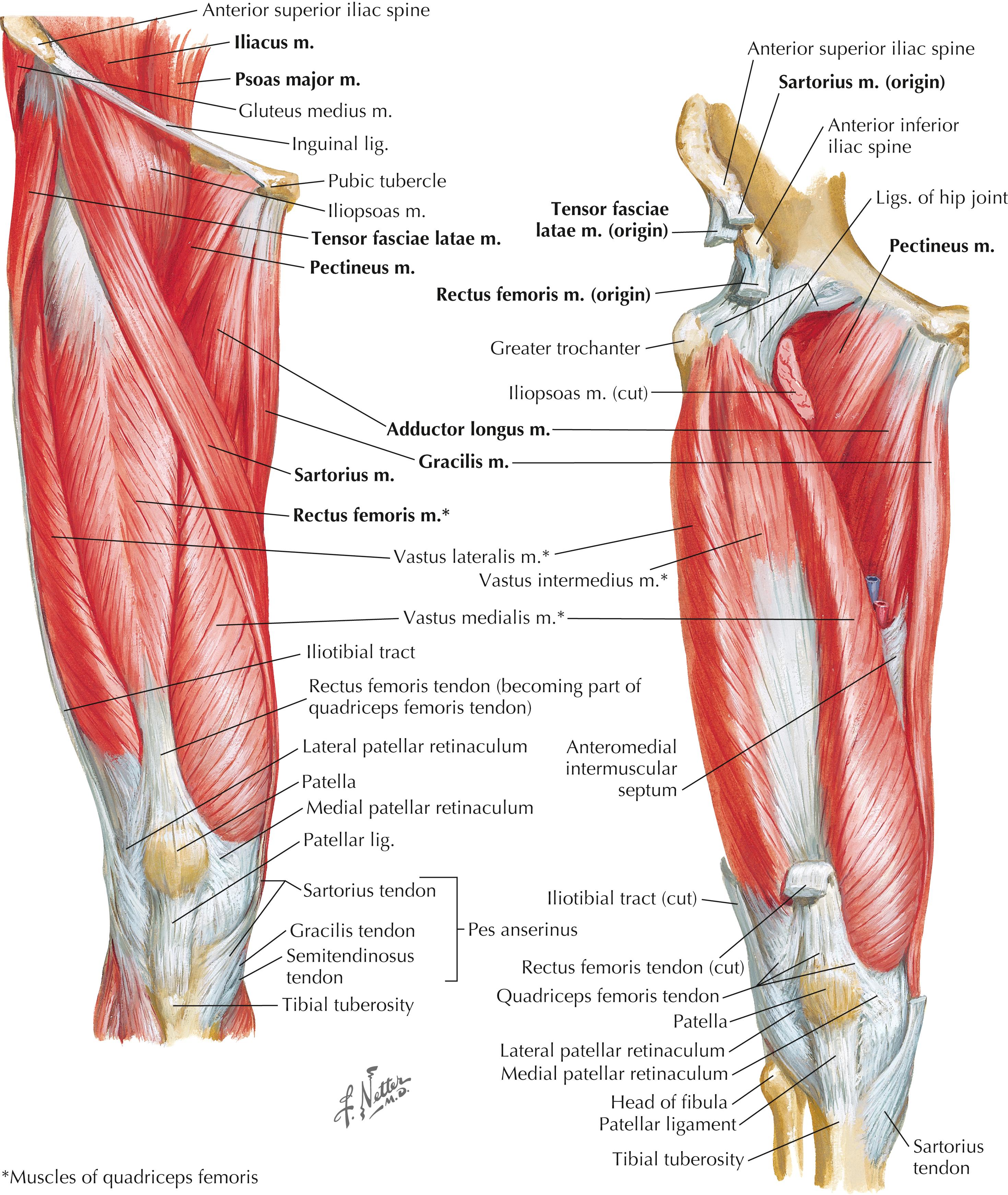
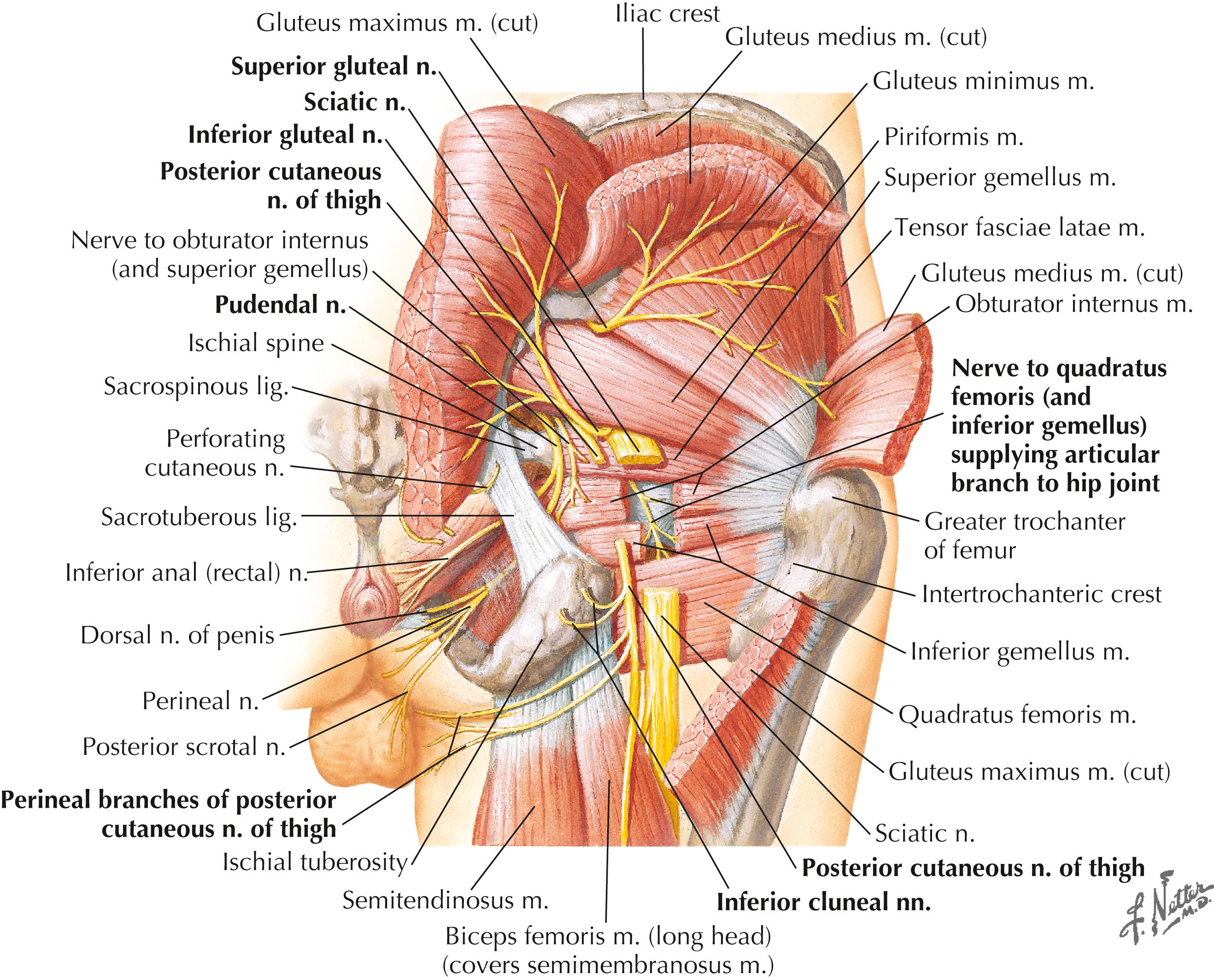
| Nerve | Segmental Level | Sensory | Motor |
|---|---|---|---|
| Obturator | L2, L3, L4 | Medial thigh | Adductor longus, adductor brevis, adductor magnus (adductor part), gracilis, obturator externus |
| Saphenous | Femoral nerve | Medial leg and foot | No motor |
| Femoral | L2, L3, L4 | Thigh via cutaneous nerves | Iliacus, sartorius, quadriceps femoris, articularis genu, pectineus |
| Lateral cutaneous of thigh | L2, L3 | Lateral thigh | No motor |
| Posterior cutaneous of thigh | S2, S3 | Posterior thigh | No motor |
| Inferior cluneal | Dorsal rami L1, L2, L3 | Buttock region | No motor |
| Sciatic | L4, L5, S1, S2, S3 | Hip joint | Knee flexors and all muscles of lower leg and foot |
| Superior gluteal | L4, L5, S1 | No sensory | Tensor fasciae latae, gluteus medius, gluteus minimus |
| Inferior gluteal | L5, S1, S2 | No sensory | Gluteus maximus |
| Nerve to quadratus femoris | L5, S1, S2 | No sensory | Quadratus femoris, inferior gemellus |
| Pudendal | S2, S3, S4 | Genitals | Perineal muscles, external urethral sphincter, external anal sphincter |
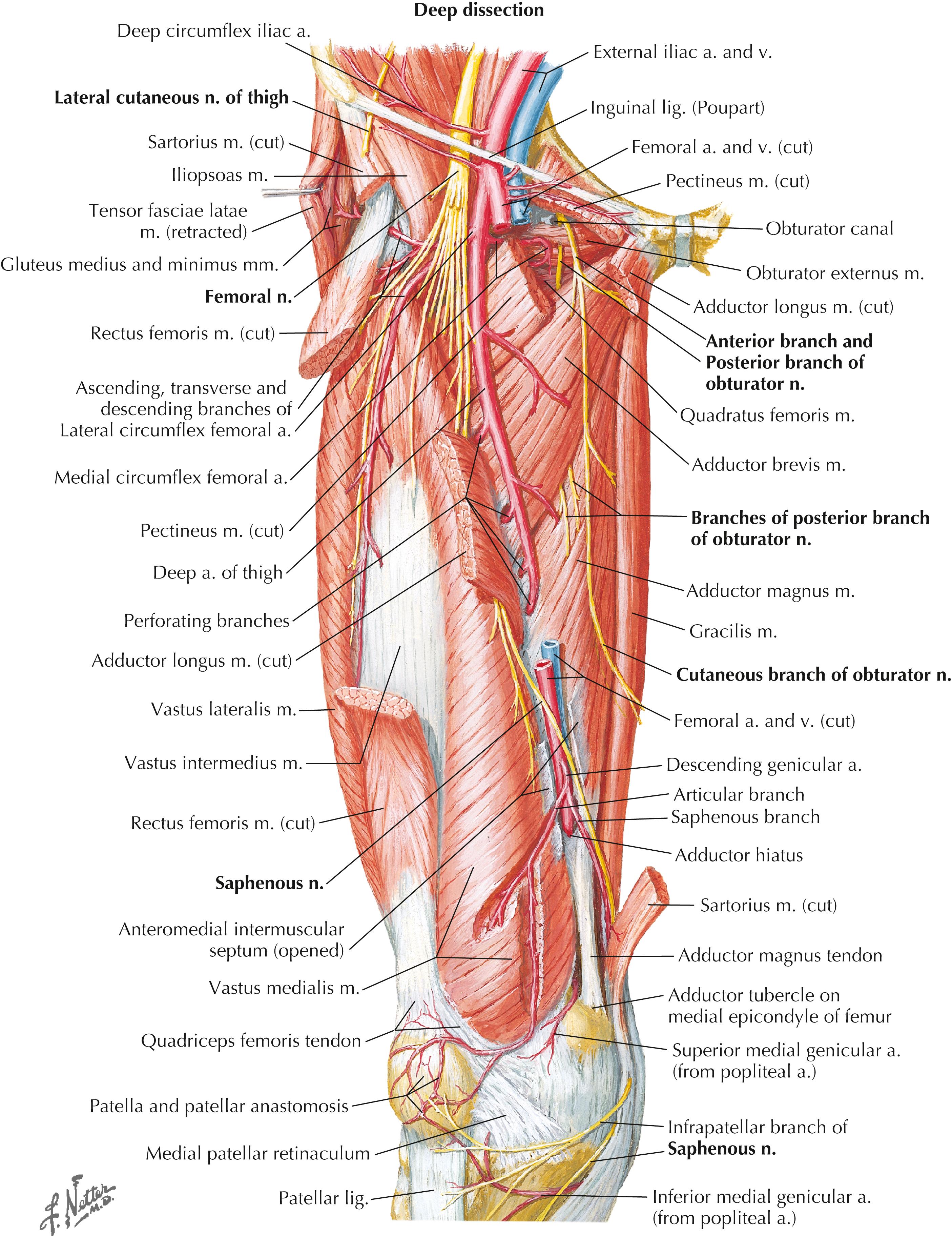
| History | Initial Hypothesis |
|---|---|
| Reports of pain at the lateral thigh. Pain exacerbated when transferring from sitting to standing | Greater trochanteric bursitis Muscle strain |
| Age over 60 years. Reports of pain and stiffness in the hip with possible radiation into the groin | OA |
| Reports of clicking or catching in the hip joint. Pain exacerbated by full flexion or extension | Labral tear |
| Reports of a repetitive or an overuse injury | Muscle sprain/strain |
| Deep aching throb in the hip or groin. Possible history of prolonged steroid use | Avascular necrosis |
| Sharp pain in groin. Often misdiagnosed by multiple providers | Femoroacetabular (anterior) impingement |
| Pain in the gluteal region with occasional radiation into the posterior thigh and calf | Piriformis syndrome Hamstring strain , Ischial bursitis |
| Patient Complaint and Study Quality | Population | Reference Standard | Sens | Spec | +LR | −LR |
|---|---|---|---|---|---|---|
| Constant low back/buttock pain |
78 patients with unilateral pain in the buttock, groin, or anterior thigh | Hip OA on radiographs using the Kellgren and Lawrence grading scale | .52 (.30, .74) | .92 (.80, .97) | 6.4 (2.4, 17.4) | .52 (.33, .81) |
| Ipsilateral groin pain |
.29 (.12, .52) | .92 (.80, .97) | 3.6 (1.2, 11.0) | .78 (.59, 1.00) | ||
| Squatting aggravates symptoms |
.76 (.52, .91) | .57 (.42, .70) | 1.8 (1.2, 2.6) | .42 (.19, .93) | ||
| No lateral thigh pain |
49 potential surgical patients with hip pain | Intraarticular hip pain as defined by relief of more than 50% with intraarticular anesthetic-steroid injection | .78 (.59, .89) | .36 (.2, .57) | 1.2 (.84, 1.8) | .61 (.25, 1.5) |
| Groin pain 7 |
.59 (.41, .75) | .14 (.05, .33) | .67 (.48, .98) | 3.0 (.95, 9.4) | ||
| Catching |
.63 (.44, .78) | .54 (.35, .73) | 1.39 (.81, 2.4) | .68 (.36, 1.3) | ||
| Pinching pain when sitting |
.48 (.31, .66) | .54 (.35, .73) | 1.1 (.58, 1.9) | .95 (.56, 1.6) | ||
| Patient complains of clicking in the hip |
18 patients with hip pain | Acetabular labral tear as determined by magnetic resonance arthrography | 1.0 (.48, 1.0) | .85 (.55, .98) | 6.7 | .00 |
| Measurements and Study Quality | Instrumentation | Population | Interexaminer Reliability |
|---|---|---|---|
| External rotation (sitting) Internal rotation (sitting) External rotation (supine) Internal rotation (supine) Flexion Abduction Adduction Extension |
Goniometer | 6 patients with hip OA | Prestandardization/poststandardization: ICC = .55/.80 ICC = .95/.94 ICC = .87/.80 ICC = .87/.94 ICC = .91/.91 ICC = .91/.88 ICC = .72/.56 ICC = NA/.66 |
| Passive hip flexion |
Gravity inclinometer | 22 patients with knee OA and 17 asymptomatic subjects | ICC = .94 (.89 to .97) |
| Internal rotation |
Digital inclinometer | 25 healthy subjects | ICC = .93 (.84, .97) |
| Internal rotation External rotation Flexion Abduction Extension (knee flexed) Extension (knee unconstrained) |
Goniometer (except rotation with inclinometer) | 22 patients with hip OA | ICC = .93 (.83, .97) ICC = .96 (.91, .99) ICC = .97 (.93, .99) ICC = .94 (.86, .98) ICC = .86 (.67, .94) ICC = .89 (.72, .95) |
| Flexion Abduction Adduction External rotation Internal rotation Extension |
Inclinometer | 78 patients with unilateral pain in the buttock, groin, or anterior thigh | ICC = .85 (.64 to .93) ICC = .85 (.68 to .93) ICC = .54 (−.19 to .81) ICC = .77 (.53 to .89) ICC = .88 (.74 to .94) ICC = .68 (.32 to .85) |
| Flexion Extension Abduction Adduction External rotation Internal rotation Total hip motion |
Goniometer | 25 subjects with radiologically verified OA of the hip | ICC = .82 ICC = .94 ICC = .86 ICC = .50 ICC = .90 ICC = .90 ICC = .85 |
| Flexion Internal rotation External rotation Abduction Extension Adduction |
Goniometer | 167 patients, 50 with no hip OA, 77 with unilateral hip OA, 40 with bilateral hip OA based on radiologic reports | ICC = .92 ICC = .90 ICC = .58 ICC = .78 ICC = .56 ICC = .62 |
| Hip flexion, right Hip flexion, left |
Goniometer | 106 patients with OA of the hip or knee confirmed by a rheumatologist or an orthopaedic surgeon | ICC = .82 (.26, .95) ICC = .83 (.33, .96) |
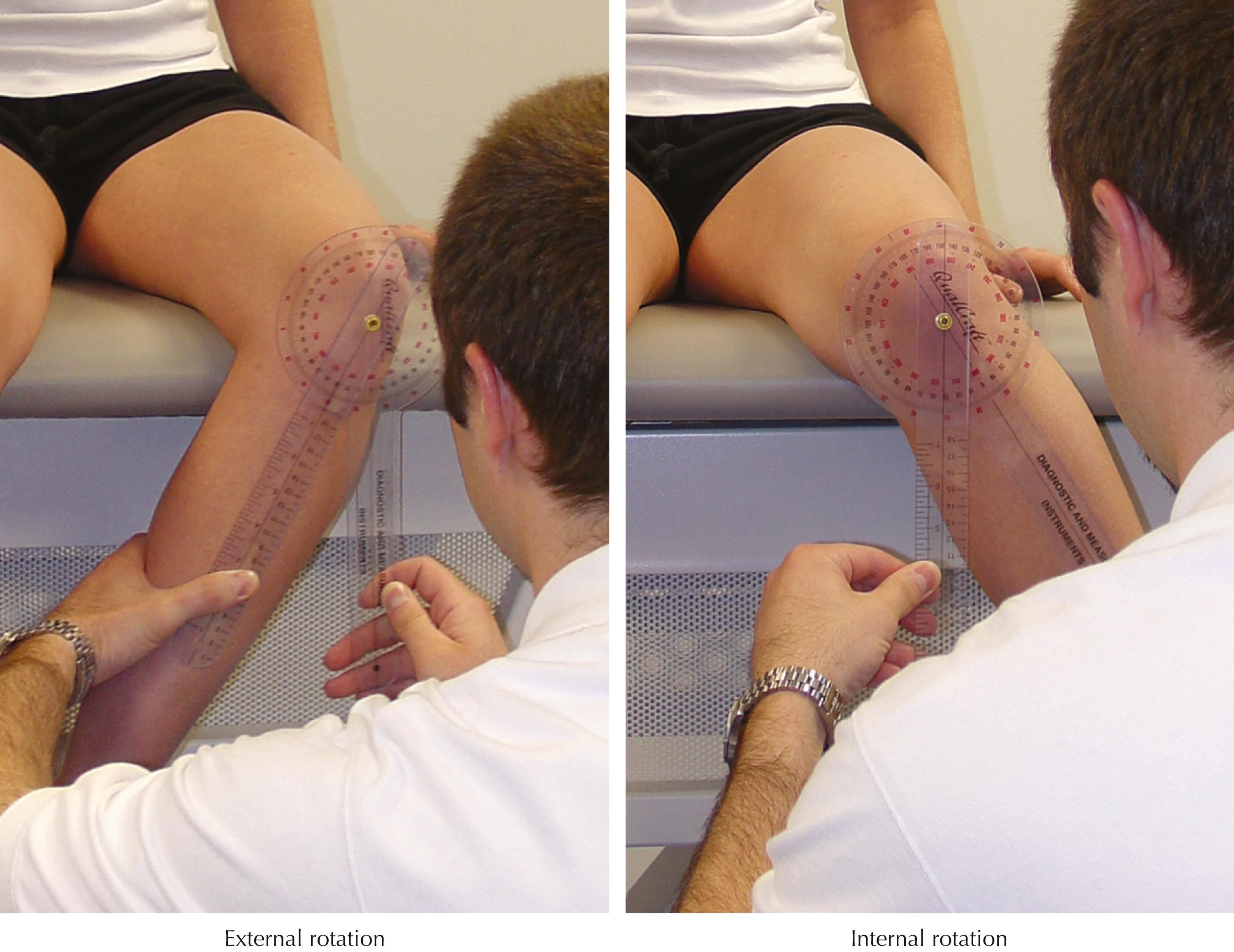
| Measurements and Study Quality | Description and Positive Finding | Population | Intraexaminer Reliability |
|---|---|---|---|
| Flexion test |
Maximal passive range of motion was assessed. End feels were dichotomized into “capsular” (early capsular, spasm, bone-to-bone) and “noncapsular” (soft tissue approximation, springy block, and empty) as defined by Cyriax | 78 patients with unilateral pain in the buttock, groin, or anterior thigh | κ =.21 (−.22, .64) |
| Internal rotation test |
κ = .51 (.19, .83) | ||
| Scour test |
κ = .52 (.08, .96) | ||
| Patrick (FABER) test |
κ = .47 (.12, .81) | ||
| Hip flexion test |
κ = .52 (.09, .96) |
A few studies , have investigated the diagnostic utility of Cyriax’s capsular pattern (greater limitation of flexion and internal rotation than of abduction, little if any limitation of adduction and external rotation) in detecting the presence of OA of the hip. Bijl and associates demonstrated that hip joints with OA had significantly lower range-of-motion values in all planes when compared with hip joints without OA. However, the magnitude of the range limitations did not follow Cyriax’s capsular pattern. Similarly, Klässbo and colleagues did not detect a correlation between hip OA and Cyriax’s capsular pattern. In fact, they identified 138 patterns of passive range-of-motion restrictions depending on the established norms used (either the mean for symptom-free hips or Kaltenborn’s published norms).
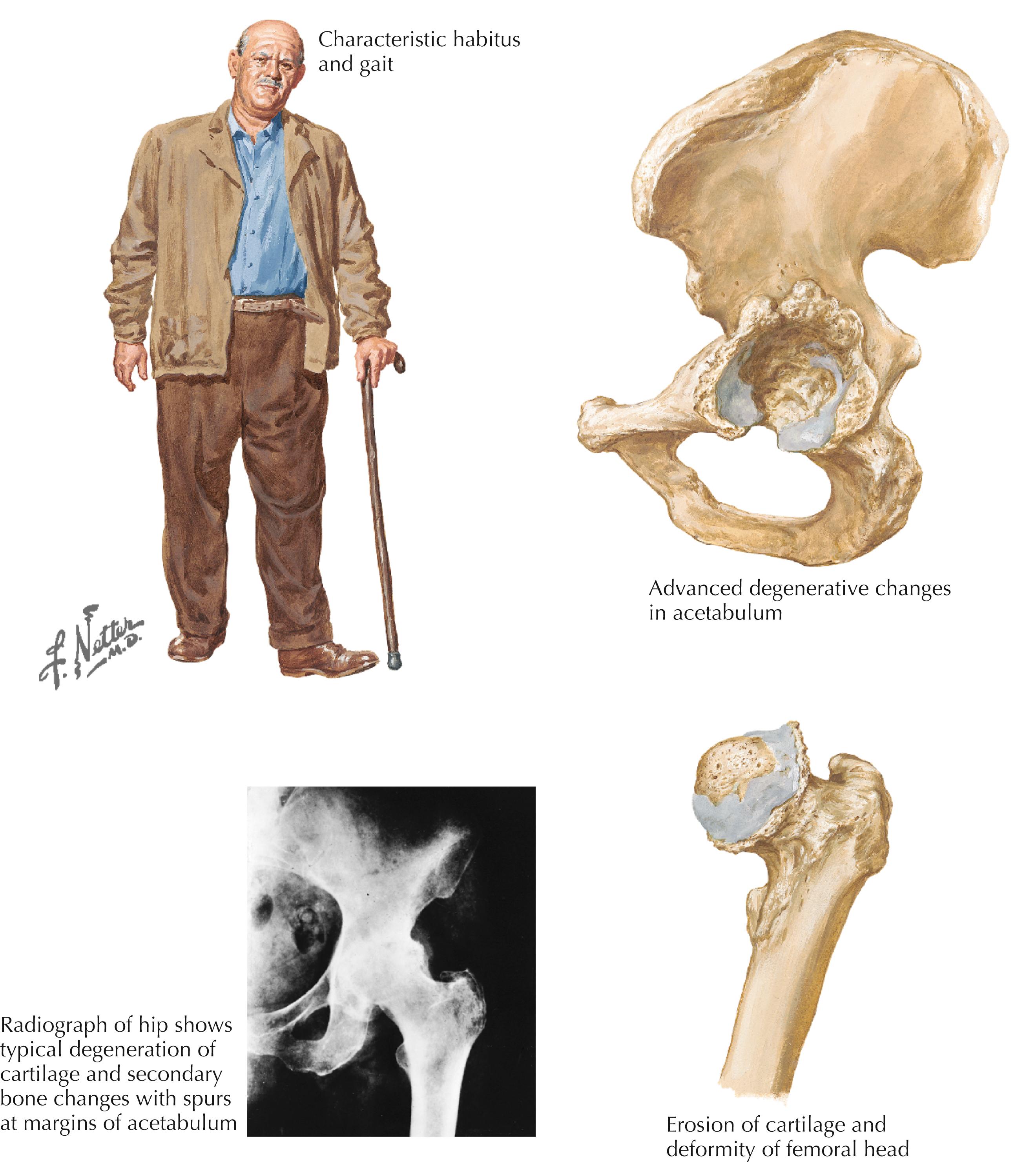
Become a Clinical Tree membership for Full access and enjoy Unlimited articles
If you are a member. Log in here